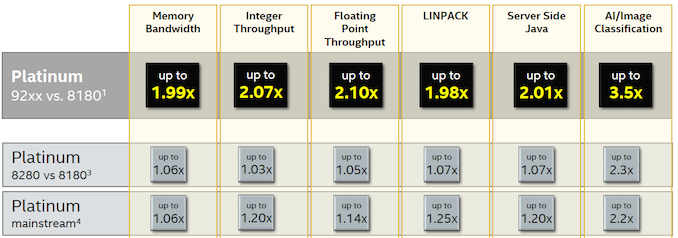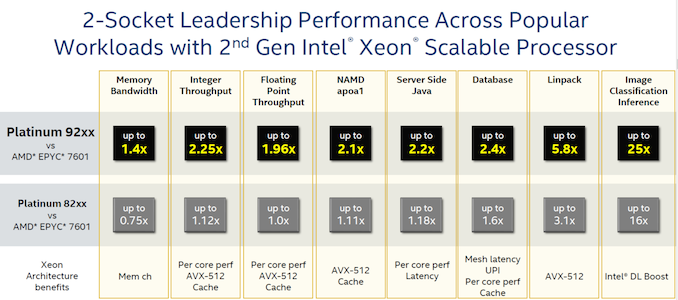Intel's Xeon Cascade Lake vs. NVIDIA Turing: An Analysis in AI
by Johan De Gelas on July 29, 2019 8:30 AM ESTCPU Performance: Intel's Own Claims
Before we get into the new AI benchmarks, let’s take a quick look at the usual CPU benchmarks and performance claims made available by Intel.
For this comparison we’ll focus on the second row – the first row is comparing the insanely priced 400W dual-die Intel Platinum 9282 to a much more reasonable and available to everyone Intel Platinum 8180. The second row tells it all: a few MHz and slightly higher RAM speeds result in a 3% (Integer) to 5% (FP) performance increase compared to the first-generation Xeon Scalable parts. The higher boost in floating point performance is probably the result of the fact that Intel's second generation parts can use faster DDR4-2933 DIMMs and hence offer more bandwidth to the cores.
The midrange SKUs get a bigger boost as some of x2xx Xeon Scalable parts get more cores and more L3 cache than the previous x1xx parts. For example, the 6252 has 24 cores and 35.75 MB L3, while the 6152 had 22 cores and 30.25 MB L3.
The comparison with AMD's EPYC 7601 however deserves our attention, as there’s some interesting data here. Again, the comparison of a 400W, $50k chiplet CPU with a 180W $4k one does not make any sense whatsoever, so we ignore the first line.
The Linpack numbers are not surprising: the more expensive Skylake SKUs add a 512-bit FMAC to the already existing dual 256-bit FMACs, offering up to 4 times more AVX throughput than AMD's EPYC. AMD's next generation will be a lot more competitive in this area as the each FP unit is now capable of doing 256-bit AVX instead of 128-bit.
The image classification results clearly show that Intel is trying to convince people that some AI applications should simply run on a CPU, no GPU needed. Well, at least for now…
The fact that Intel claims that database performance is a lot better than on the EPYC is quite interesting, as we’ve previously pointed out that AMD's four NUMA dies on a chip does have drawbacks. Quoting our Xeon Skylake vs EPYC review:
Out of the box, the EPYC CPU is a rather mediocre transactional database CPU ... transactional databases will remain Intel territory for now.
In databases, cache (coherency) latency plays an important role. It will be interesting to see how well AMD has addressed this weakness in the second generation EPYC server chips.












56 Comments
View All Comments
C-4 - Monday, July 29, 2019 - link
It's interesting that optimizations did so much for the Intel processors (but relatively less for the AMD ones). Who made these optimizations? How much time was devoted to doing this? How close are the algorithms to being "fully optimized" for the AMD and nVidia chips?quorm - Monday, July 29, 2019 - link
I believe these optimizations largely take advantage of AVX512, and are therefore intel specific, as amd processors do not incorporate this feature.RSAUser - Monday, July 29, 2019 - link
As quorm said, I'd assume it's due to AVX512 optimizations, the next generation of AMD Epyc CPU's should support it, and I am hoping closer to 3GHz clock speeds on the 64 core chips, since it seems the new ceiling is around the 4GHz mark for 16 all-core.It will be an interesting Q3/Q4 for Intel in the server market this year.
SarahKerrigan - Monday, July 29, 2019 - link
Next generation? You mean Rome? Zen2 doesn't have any AVX512.HStewart - Tuesday, July 30, 2019 - link
I believe AMD AVX 2 is dual-128 bit instead of 256bit - so AVX 512 would probably be quad 128bit .jospoortvliet - Tuesday, July 30, 2019 - link
That’s not really how it works, in the sense that you explicitly need to support the new instructions... and amd doesn’t (plan to, as far as we know).Qasar - Tuesday, July 30, 2019 - link
from wikipedia :" AVX2 is now fully supported, with an increase in execution unit width from 128-bit to 256-bit. "
" AMD has increased the execution unit width from 128-bit to 256-bit, allowing for single-cycle AVX2 calculations, rather than cracking the calculation into two instructions and two cycles."
which is from here : https://www.anandtech.com/show/14525/amd-zen-2-mic...
looks like AVX2 is single 256 bit :-)
name99 - Monday, July 29, 2019 - link
Regarding the limits of large batches: while this is true in principle, the maximum size of those batches can be very large, is hard to predict (at leas right now) and there is on-going work to increase the sizes, This link describes some of the issue and what’s known:http://ai.googleblog.com/2019/03/measuring-limits-...
I think Intel would be foolish to pin many hopes on the assumption that batch scaling will soon end the superior performance of GPUs and even more specialized hardware...
brunohassuna - Monday, July 29, 2019 - link
Some information about energy consumption would very useful in comparisons like thatozzuneoj86 - Monday, July 29, 2019 - link
My first thought when clicking this article was how much more visibly-complex CPUs have gotten in the past ~35 years.Compare the bottom of that Xeon to the bottom of a CLCC package 286:
https://en.wikipedia.org/wiki/Intel_80286#/media/F...
And that doesn't even touch the difference internally... 134,000 transistors to 8 million and from 16Mhz to 4,000Mhz. The mind boggles.